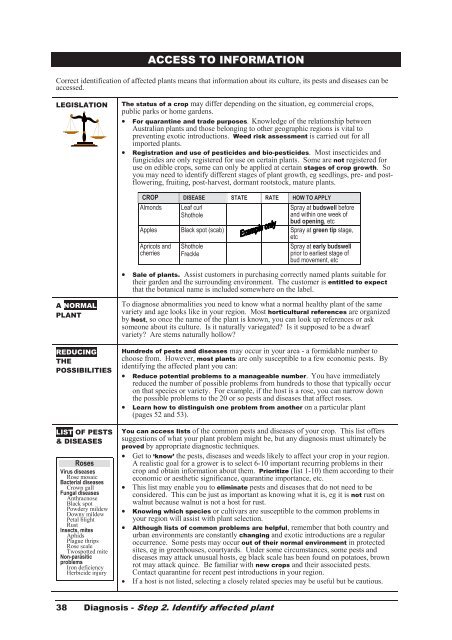PLANT PROTECTION 4
PLANT PROTECTION 4
PLANT PROTECTION 4
Create successful ePaper yourself
Turn your PDF publications into a flip-book with our unique Google optimized e-Paper software.
ACCESS TO INFORMATION<br />
Correct identification of affected plants means that information about its culture, its pests and diseases can be<br />
accessed.<br />
LEGISLATION<br />
A NORMAL<br />
<strong>PLANT</strong><br />
REDUCING<br />
THE<br />
POSSIBILITIES<br />
LIST OF PESTS<br />
& DISEASES<br />
Roses<br />
Virus diseases<br />
Rose mosaic<br />
Bacterial diseases<br />
Crown gall<br />
Fungal diseases<br />
Anthracnose<br />
Black spot<br />
Powdery mildew<br />
Downy mildew<br />
Petal blight<br />
Rust<br />
Insects, mites<br />
Aphids<br />
Plague thrips<br />
Rose scale<br />
Twospotted mite<br />
Non-parasitic<br />
problems<br />
Iron deficiency<br />
Herbicide injury<br />
The status of a crop may differ depending on the situation, eg commercial crops,<br />
public parks or home gardens.<br />
For quarantine and trade purposes. Knowledge of the relationship between<br />
Australian plants and those belonging to other geographic regions is vital to<br />
preventing exotic introductions. Weed risk assessment is carried out for all<br />
imported plants.<br />
Registration and use of pesticides and bio-pesticides. Most insecticides and<br />
fungicides are only registered for use on certain plants. Some are not registered for<br />
use on edible crops, some can only be applied at certain stages of crop growth. So<br />
you may need to identify different stages of plant growth, eg seedlings, pre- and postflowering,<br />
fruiting, post-harvest, dormant rootstock, mature plants.<br />
CROP DISEASE STATE RATE HOW TO APPLY<br />
Almonds Leaf curl<br />
Shothole<br />
38 Diagnosis - Step 2. Identify affected plant<br />
Spray at budswell before<br />
and within one week of<br />
bud opening, etc<br />
Apples Black spot (scab) Spray at green tip stage,<br />
etc<br />
Apricots and Shothole<br />
Spray at early budswell<br />
cherries Freckle<br />
prior to earliest stage of<br />
bud movement, etc<br />
Sale of plants. Assist customers in purchasing correctly named plants suitable for<br />
their garden and the surrounding environment. The customer is entitled to expect<br />
that the botanical name is included somewhere on the label.<br />
To diagnose abnormalities you need to know what a normal healthy plant of the same<br />
variety and age looks like in your region. Most horticultural references are organized<br />
by host, so once the name of the plant is known, you can look up references or ask<br />
someone about its culture. Is it naturally variegated? Is it supposed to be a dwarf<br />
variety? Are stems naturally hollow?<br />
Hundreds of pests and diseases may occur in your area - a formidable number to<br />
choose from. However, most plants are only susceptible to a few economic pests. By<br />
identifying the affected plant you can:<br />
Reduce potential problems to a manageable number. You have immediately<br />
reduced the number of possible problems from hundreds to those that typically occur<br />
on that species or variety. For example, if the host is a rose, you can narrow down<br />
the possible problems to the 20 or so pests and diseases that affect roses.<br />
Learn how to distinguish one problem from another on a particular plant<br />
(pages 52 and 53).<br />
You can access lists of the common pests and diseases of your crop. This list offers<br />
suggestions of what your plant problem might be, but any diagnosis must ultimately be<br />
proved by appropriate diagnostic techniques.<br />
Get to ‘know’ the pests, diseases and weeds likely to affect your crop in your region.<br />
A realistic goal for a grower is to select 6-10 important recurring problems in their<br />
crop and obtain information about them. Prioritize (list 1-10) them according to their<br />
economic or aesthetic significance, quarantine importance, etc.<br />
This list may enable you to eliminate pests and diseases that do not need to be<br />
considered. This can be just as important as knowing what it is, eg it is not rust on<br />
walnut because walnut is not a host for rust.<br />
Knowing which species or cultivars are susceptible to the common problems in<br />
your region will assist with plant selection.<br />
Although lists of common problems are helpful, remember that both country and<br />
urban environments are constantly changing and exotic introductions are a regular<br />
occurrence. Some pests may occur out of their normal environment in protected<br />
sites, eg in greenhouses, courtyards. Under some circumstances, some pests and<br />
diseases may attack unusual hosts, eg black scale has been found on potatoes, brown<br />
rot may attack quince. Be familiar with new crops and their associated pests.<br />
Contact quarantine for recent pest introductions in your region.<br />
If a host is not listed, selecting a closely related species may be useful but be cautious.






![[Compatibility Mode].pdf](https://img.yumpu.com/27318716/1/190x135/compatibility-modepdf.jpg?quality=85)










